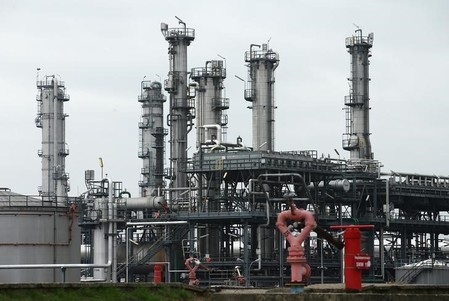By Henning Gloystein
SINGAPORE (Reuters) – Oil prices shot to their highest levels since mid-2015 on Monday after OPEC and other producers reached their first deal since 2001 to jointly reduce output in order to rein in oversupply and prop up markets.
Brent crude, the international benchmark for oil prices, soared to $57.89 per barrel in overnight trading between Sunday and Monday, the highest level since July 2015.
U.S. West Texas Intermediate (WTI) crude also hit a July 2015 high of $54.51 a barrel.
Brent and WTI eased to $56.83 and $54.07 respectively by 0629 GMT, but were both still up over 4 percent from their last settlements.
With the deal signed after almost a year of arguing within the Organization of the Petroleum Exporting Countries and mistrust in the willingness of non-OPEC Russia to participate, focus is switching to compliance of the agreement.
“We believe that the obser vation of the OPEC-11 and non-OPEC 11 production cuts is required to sustainably support… oil prices to our 1H17 WTI price forecast of $55 a barrel,” Goldman Sachs said.
“This forecast reflects an effective 1.0 million barrels per day (bpd) cut vs. the 1.6 million bpd announced cut and greater compliance to the announced cuts is therefore an upside risk to our forecasts.”
AB Bernstein said the agreed deal “amounts to an aggregate supply cut of 1.76 million barrels per day (bpd) from 24 countries which currently produce 52.6 million bpd, or 54 percent of world oil supply.”
Bernstein said that “some of the non-OPEC supply cuts will come from natural decline, but most will come from self-imposed cuts.”
Saudi Aramco has told U.S. and European customers it will reduce oil deliveries from January.
“The kingdom is targeting excess inventories, the lion’s share of which sit in the United States,” said Virendra Chauhan, oil analyst at Energy Aspects in Singapore. “Lower Saudi exports to the U.S. could also make the export arbitrage uneconomic.”
OPEC plans to slash output by 1.2 million bpd from Jan. 1, with top exporter Saudi Arabia cutting around 486,000 bpd in a bid to end overproduction that has dogged markets for two years.
On Saturday, producers from outside OPEC agreed to reduce output by 558,000 bpd, short of the target of 600,000 bpd but still the largest contribution by non-OPEC ever.
“Non-OPEC participation should add to bullish sentiment,” Morgan Stanley said.
From outside OPEC, Russia said it would gradually cut 300,000 bpd.
“Once cuts are implemented at the start of 2017, oil markets will shift from surplus into deficit. Given the cuts in production announced by OPEC, we expect that markets will move into a 0.8 million bpd deficit in 1H17,” AB Bernstein said.
Still, some analysts expect producers, drawn by higher oil prices, to increase output again.
“While better compliance than we expect would initially lead to higher prices – with full compliance worth an additional $6 per barrel to our price forecast – we expect that a greater producer response, especially in the U.S., would eventually bring prices back to $55,” Goldman Sachs said.
(Additional reporting by Florence Tan and Keith Wallis; Editing by Richard Pullin)


